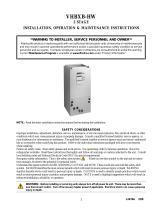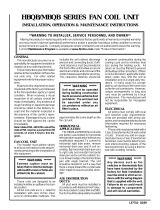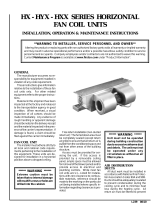
INSTALLATION
PRECAUTIONS
Installation of this fan coil should
only be performed by a licensed con-
tractor to ensure proper installation
and the safety of the installer. The
following are some precautions to be
followed for typical installations.
Always use proper tools and equip-
ment.
No wiring or other work should be
attempted without first ensuring that
the fan coil is completely discon-
nected from the power source and
locked out. Always verify that a good
ground connection exists prior to en-
ergizing any power sources.
Always review the nameplate on
each unit for proper voltage and con-
trol configurations. This information
is determined from the components
and wiring of the unit and may vary
from unit to unit.
Use the directional arrows or other
information on the filter to determine
the proper flow direction.
Ensure that the air distribution sys-
tem does not exceed the external
static rating of the unit.
NOISE
These fan coil units are designed for
quiet operation, however, all air condi-
tioning equipment will transfer some
amount of noise to the conditioned
space. This should be taken into
consideration when planning the lo-
cation of the equipment.
MOUNTING
It is important to ensure that the fan
coils are securely mounted and the
structure is sufficient to support the
weight of the equipment. All anchors
for mounting the equipment must be
placed and sized to ensure a safe and
durable installation.
CAUTION: It is highly recom-
mended that an auxilliary drain
pan be located beneath the fan
coil to prevent damage which
may result from an overflow of the
condensate pan.
COOLING COIL PIPING
These fan coil units are supplied
with a direct expansion refrigerant
coil. The suction and liquid refrigerant
lines must be sized in accordance
with the outdoor unit manufacturers
recommendations.
NOTE: If a Condensate Overflow
Shut-off Switch, that is designed to
be installed in the drain line, is used
in place of a secondary drain line,
then the cut-off switch should be
located in the primary drain line be-
tween the fan coil unit and the P-trap.
OPERATION AND
MAINTENANCE
Pre-start Check
Check that supply voltage matches
nameplate data.
Ensure that the unit is properly
grounded.
With power off, check blower wheel
set screws for tightness and ensure
that the blower wheels rotates freely
and quietly.
Check that the refrigerant coil con-
nections and piping have been leak
checked and insulated as required.
Start-up and Maintenance
Before start-up, all of the compo-
nents should be given a thorough
check. Optimal operation of this
equipment requires cleanliness. Of-
ten after installation of this equipment
additional construction activities oc-
cur. Care must be taken to protect
the equipment from debris during
these construction phases. All ac-
cess panels and filters must be in
place before operation of the units.
Fan
The fan should be inspected and
cleaned, in conjunction with mainte-
nance of the motor and bearings. It is
important to keep the wheels clean in
order to avoid imbalance and vibra-
tion.
****** WARNING ******
When connecting piping to
fan coil units, do not bend or
reposition the coil header tub-
ing for alignment purposes.
This could cause a tubing frac-
ture resulting in a refrigerant
leak when pressure is applied
to the system.
****** WARNING ******
Do not touch any rotating
component with any object.
Damage to the equipment and
personal injury can occur.
****** WARNING ******
Any devices such as fan
switches or thermostats that
have been furnished by the
factory for field installation
must be wired in strict accor-
dance with the wiring diagram
that is supplied with the unit.
Failure to do so could result
in damage to components
and will void all warranties.
Condensate drain lines must be
installed with adequate slope away
from the unit to assure positive drain-
age. Since the drain pan is located on
the suction side of the blower, a
negative pressure exists at the drain
pan and a minimum trap of 1-1/2
inches must be provided in the drain
line to assure proper drainage.
When soldering or brazing to the
unit, it is recommended to have a fire
extinguisher readily available. When
soldering close to metering devices or
other components, heat shields or
wet rags are required to prevent dam-
age.
When the fan coil unit is in operation
components are rotating at high
speeds.
Units must be installed level to
ensure proper drainage and opera-
tion.
Check unit prior to operation to
ensure that the condensate water will
drain toward the drain connection. An
overflow drain or an auxiliary drain pan
under the fan coil may be required as
a back up to a clogged primary drain.
Be sure that the drain pan is free
from foreign material prior to start up.
Check filter media installation to
ensure that it is installed correctly.
Motor
Check motor connections to en-
sure that they are secure and made in
accordance with the wiring diagram.
The blower motor should be
cleaned annually.
Filter
The air filter should be cleaned or
replaced as often as necessary to
prevent restriction of air flow. Always






